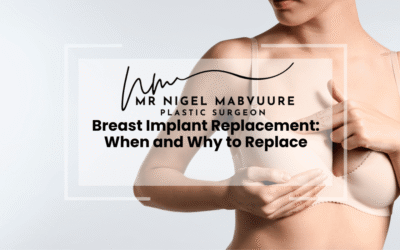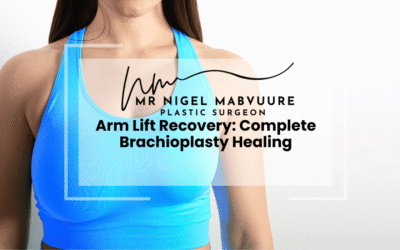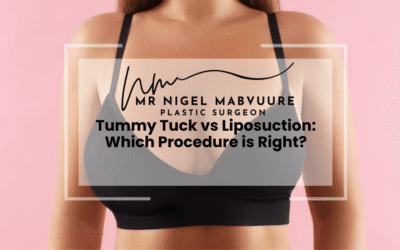Key Takeaways
- Recovery timelines vary by procedure—minimally invasive treatments require 24-48 hours, facial surgeries 2-3 weeks for social presentability, and body procedures 2-4 weeks before returning to non-strenuous work.
- Follow your surgeon’s specific aftercare instructions for wound care, medication, activity restrictions, and compression garment use to ensure optimal healing.
- Speed healing through proper hydration (2-3 liters daily), gentle movement to promote circulation, appropriate cold therapy, and early scar management.
- Optimize recovery with increased protein intake (1.5-2g per kg of body weight), vitamin C-rich foods, adequate sleep (7-9 hours), and complete smoking cessation.
- Avoid nicotine, alcohol, blood-thinning medications, submerging incisions in water, and exposing scars to direct sunlight during your recovery period.
- Manage pain effectively through prescribed medications, appropriate cold therapy, strategic positioning, and relaxation techniques to improve comfort during healing.
Table of Contents
- Understanding the Post-Surgery Recovery Process: What to Expect
- Essential Plastic Surgery Aftercare Guidelines for Cheshire Patients
- How Long Does Plastic Surgery Recovery Actually Take?
- Proven Techniques to Speed Up Your Surgical Healing
- Nutrition and Lifestyle Factors That Optimize Recovery
- What Should I Avoid After Surgery? Critical Do’s and Don’ts
- Managing Pain and Discomfort During Your Recovery Journey
- When to Contact Your Cheshire Surgeon: Warning Signs to Watch For
Understanding the Post-Surgery Recovery Process: What to Expect
Post-surgery recovery is a critical phase in your plastic surgery journey that significantly influences your final results. For patients in Cheshire undergoing cosmetic procedures, understanding what to expect during this healing period can help alleviate anxiety and promote optimal outcomes. The recovery process typically begins immediately after your procedure when you’re moved to a recovery room for monitoring.
During the initial 24-48 hours, you’ll likely experience some degree of discomfort, swelling, and possibly bruising—all normal responses as your body begins its healing process. These symptoms are your body’s natural inflammatory response to surgical intervention. The intensity varies depending on the specific procedure, with more extensive surgeries like abdominoplasty or facelift requiring longer initial recovery periods than minimally invasive treatments.
Your surgeon will provide specific post-operative instructions tailored to your procedure. These typically include guidance on wound care, medication schedules, activity restrictions, and follow-up appointments. Following these instructions precisely is crucial for proper healing and achieving optimal aesthetic results. Most patients transition through several recovery phases, beginning with acute recovery (first few days), followed by subacute recovery (first few weeks), and finally, the remodelling phase (several months), during which final results gradually emerge.
Throughout your recovery journey, patience is essential. Your body needs adequate time to heal properly, and rushing this process can compromise your results. Remember that each patient’s recovery experience is unique, influenced by factors including age, overall health, the specific procedure performed, and how diligently you follow aftercare instructions.
Essential Plastic Surgery Aftercare Guidelines for Cheshire Patients
For Cheshire residents recovering from plastic surgery, following structured aftercare guidelines is paramount to achieving optimal results. Your surgeon will provide personalised instructions, but these general principles apply to most cosmetic procedures and help ensure a smooth recovery process.
Wound care forms the foundation of effective aftercare. Keep incision sites clean and dry according to your surgeon’s specific instructions. Some dressings need to remain undisturbed for a set period, while others require regular changing. When cleaning incision areas, use only the recommended cleansers—typically mild, fragrance-free options that won’t irritate healing tissues.
Medication management is equally important. Take all prescribed medications exactly as directed, including antibiotics (which must be completed even if you feel well), pain relievers, and any anti-inflammatory drugs. Never adjust dosages without consulting your surgeon, and inform them of any adverse reactions promptly.
Activity restrictions vary by procedure but generally involve avoiding strenuous exercise, heavy lifting, and certain body positions that might strain incision sites. For facial procedures, keeping your head elevated helps reduce swelling, while procedures on the body often require specific sleeping positions to avoid pressure on surgical sites.
Compression garments play a crucial role in many recoveries, particularly after body contouring procedures. These specially designed garments help reduce swelling, support healing tissues, and help shape your final results. Wear them exactly as prescribed—typically 23 hours daily during the initial recovery phase.
Cheshire patients benefit from the region’s excellent medical facilities for follow-up care. Attend all scheduled post-operative appointments, even if you feel your recovery is progressing well. These check-ups allow your surgeon to monitor healing, address complications early, and adjust your recovery plan if necessary.
How Long Does Plastic Surgery Recovery Actually Take?
Recovery timelines after plastic surgery vary significantly depending on the procedure’s complexity, your individual healing capacity, and how closely you follow post-operative instructions. Understanding realistic timeframes helps Cheshire patients plan appropriately and maintain reasonable expectations throughout their healing journey.
For minimally invasive procedures like Botox or dermal fillers, recovery is remarkably quick. Most patients experience minimal downtime of 24-48 hours, with minor swelling or bruising that typically resolves within a week. You can usually return to normal activities almost immediately, though strenuous exercise should be avoided for at least 24 hours.
Facial surgical procedures such as facelifts, blepharoplasty (eyelid surgery), or rhinoplasty involve more substantial recovery periods. Initial acute recovery lasts approximately 1-2 weeks, during which visible bruising and swelling are common. Most patients feel comfortable returning to work and social activities after 2-3 weeks, though residual swelling continues to improve over 3-6 months. Complete tissue remodelling and final results may take up to a year, particularly for rhinoplasty. Our facelift recovery timeline provides more detailed information about this specific procedure.
Body contouring procedures like abdominoplasty (tummy tuck), liposuction, or breast surgeries typically require 2-4 weeks before returning to non-strenuous work. More physically demanding activities and exercise should be avoided for 6-8 weeks. While you’ll see immediate changes after surgery, final results emerge gradually as swelling subsides over 3-6 months.
It’s important to understand that these timeframes represent averages. Your personal recovery might progress faster or slower based on factors including age, overall health status, smoking history, and genetic predisposition to scarring. Younger, healthier patients typically recover more quickly, while conditions like diabetes or cardiovascular disease may extend healing times.
Throughout your recovery, progress isn’t always linear. You might experience plateaus or even temporary setbacks, which are normal parts of the healing process. Maintaining regular communication with your Cheshire surgeon ensures any concerns are addressed promptly and your recovery stays on track.
Proven Techniques to Speed Up Your Surgical Healing
While your body has its natural healing timeline, several evidence-based strategies can optimise and potentially accelerate your post-surgery recovery in Cheshire. These techniques support your body’s innate healing mechanisms without compromising the quality of your results.
Proper hydration stands as one of the simplest yet most effective ways to enhance healing. Water facilitates cellular regeneration and helps flush anaesthesia and medications from your system. Aim for at least 2-3 litres daily unless otherwise instructed by your surgeon. Hydration also helps prevent constipation—a common side effect of pain medications that can cause discomfort and strain healing tissues.
Strategic movement promotes circulation without stressing surgical sites. While strenuous activity is contraindicated, gentle walking increases blood flow, delivering oxygen and nutrients to healing tissues while reducing the risk of blood clots. Begin with short, slow walks around your home, gradually increasing duration as your recovery progresses and your surgeon approves.
Cold therapy effectively manages swelling during the initial recovery phase. Apply ice packs as directed by your surgeon—typically 20 minutes on, 20 minutes off—to reduce inflammation and discomfort. Always wrap ice packs in a thin cloth to protect your skin, and never apply directly to incision sites or areas with diminished sensation.
Lymphatic drainage massage, when approved by your surgeon, can significantly reduce swelling, particularly after liposuction or body contouring procedures. This gentle technique helps move accumulated fluid through the lymphatic system. Many Cheshire clinics offer professional lymphatic massage, or your surgeon may demonstrate self-massage techniques appropriate for your specific procedure.
Scar management should begin early for optimal results. Once incisions have closed completely and your surgeon approves, silicone sheets or gel can significantly improve scar appearance. These products create a protective microenvironment that hydrates the scar tissue and regulates collagen production, resulting in flatter, less noticeable scars. Consistent application for 12-24 hours daily over several months yields the best outcomes.
Hyperbaric oxygen therapy, available at some specialised facilities in the Cheshire area, delivers concentrated oxygen to tissues, potentially accelerating wound healing in complex cases. While not necessary for most routine recoveries, this treatment may benefit patients with compromised healing capacity or extensive surgical sites.
Nutrition and Lifestyle Factors That Optimize Recovery
Your nutritional choices and lifestyle habits significantly influence how quickly and effectively your body heals after plastic surgery. For Cheshire patients seeking optimal recovery, focusing on these modifiable factors can make a substantial difference in your healing journey and final results.
Protein intake becomes particularly crucial during recovery, as these macronutrients provide the building blocks for tissue repair. Aim for 1.5-2g of protein per kilogram of body weight daily from sources like lean meats, fish, eggs, dairy, legumes, and plant-based alternatives. If appetite is diminished after surgery, high-quality protein shakes can help meet your requirements without requiring large meals.
Vitamin C plays an essential role in collagen synthesis—the protein that gives skin its strength and elasticity. Incorporate vitamin C-rich foods like citrus fruits, berries, kiwi, and bell peppers into your diet. Similarly, zinc from foods like oysters, beef, pumpkin seeds, and lentils supports immune function and wound healing.
Omega-3 fatty acids help regulate inflammation during the healing process. Cold-water fish (salmon, mackerel, sardines), walnuts, flaxseeds, and chia seeds provide these beneficial fats. However, avoid fish oil supplements immediately before and after surgery, as they may increase bleeding risk—consult your surgeon about when to resume these supplements.
Adequate sleep becomes even more important during recovery, as your body performs much of its repair work during deep sleep cycles. Aim for 7-9 hours nightly, and consider adjusting your sleeping environment to accommodate surgical restrictions. Extra pillows can help maintain elevated positions for facial procedures or prevent rolling onto surgical sites during body contouring recovery.
Stress management techniques like gentle breathing exercises, guided meditation, or mindfulness practices support healing by reducing cortisol levels, which can otherwise impair immune function. Many patients in Cheshire find that scheduling regular relaxation periods throughout their recovery day helps maintain emotional wellbeing while their body heals.
Smoking cessation is non-negotiable for optimal healing. Nicotine severely constricts blood vessels, reducing oxygen delivery to healing tissues and significantly increasing complication risks. Most surgeons require patients to stop smoking at least four weeks before surgery and throughout the recovery period. If you’re struggling with cessation, discuss nicotine replacement options with your healthcare provider.
What Should I Avoid After Surgery? Critical Do’s and Don’ts
Following your plastic surgery in Cheshire, adhering to specific guidelines about what to avoid can prevent complications and ensure optimal results. These evidence-based recommendations help protect your surgical investment and support your body’s healing process.
DON’T:
- Smoke or use nicotine products – Nicotine constricts blood vessels, significantly impairing circulation to healing tissues. This can lead to tissue death, delayed healing, and prominent scarring. Avoid all nicotine products, including cigarettes, e-cigarettes, patches, and gum throughout your recovery period.
- Consume alcohol – Alcohol interferes with medication effectiveness, increases bleeding risk, and dehydrates tissues. Abstain completely for at least two weeks after surgery, or longer if advised by your surgeon.
- Take blood-thinning medications or supplements – Unless specifically approved by your surgeon, avoid aspirin, ibuprofen, vitamin E, fish oil, and herbal supplements like ginkgo biloba or garlic extract, all of which can increase bleeding risk.
- Submerge incisions in water – Keep incision sites dry during initial healing. Avoid swimming pools, hot tubs, and bath immersion until your surgeon confirms complete healing, typically 2-4 weeks post-surgery.
- Expose scars to direct sunlight – UV exposure can permanently darken healing scars. Keep incision sites protected from the sun for at least 12 months, using clothing, bandages, or SPF 50+ sunscreen once healing is complete.
DO:
- Follow wound care instructions precisely – Clean incisions exactly as directed, using only recommended products and techniques to prevent infection and optimize scar appearance.
- Wear compression garments as prescribed – These specialized garments support healing tissues, reduce swelling, and help shape your results. Wear them for the full duration recommended by your Cheshire surgeon.
- Attend all follow-up appointments – These visits allow your surgeon to monitor healing, remove sutures or drains at the appropriate time, and address any concerns before they become complications.
- Resume activities gradually – Follow your surgeon’s timeline for returning to exercise and daily activities. Pushing too hard too soon can compromise healing and results.
- Maintain open communication – Contact your surgical team with any questions or concerns during recovery. No concern is too small when it comes to your healing and results.
Managing Pain and Discomfort During Your Recovery Journey
Effective pain management is essential for a comfortable recovery after plastic surgery. For Cheshire patients, understanding available options and implementing a multi-faceted approach can significantly improve your healing experience while minimizing reliance on strong medications.
Your surgeon will typically prescribe pain medication appropriate for your specific procedure and medical history. Take these medications as directed—not exceeding recommended dosages but also not waiting until pain becomes severe before taking them. Staying ahead of pain with regular dosing during the first few days often provides better relief than treating breakthrough pain. Keep track of timing with a medication log to prevent accidental overdosing or missed doses.
Non-prescription pain management can supplement or eventually replace prescription medications. Paracetamol is generally safe for most patients when taken as directed. However, avoid non-steroidal anti-inflammatory drugs (NSAIDs) like ibuprofen unless specifically approved by your surgeon, as these can increase bleeding risk during the early recovery phase.
Cold therapy effectively reduces both pain and swelling, particularly during the first 48-72 hours after surgery. Apply ice packs wrapped in a thin cloth to affected areas for 20-minute intervals, allowing skin to return to normal temperature between applications. For facial procedures, specially designed facial ice packs contour comfortably to facial structures while protecting incision sites.
Positioning strategies can significantly reduce discomfort. Elevation helps minimize swelling—keep the surgical area above heart level when possible. For facial procedures, sleeping with your head elevated on 2-3 pillows reduces morning swelling and pressure. After body procedures, strategically placed pillows can prevent rolling onto surgical sites during sleep and reduce strain when sitting or lying down.
Relaxation techniques address the psychological component of pain perception. Deep breathing exercises, guided meditation, and progressive muscle relaxation can lower stress hormones that amplify pain signals. Many Cheshire patients find that dedicating 15-20 minutes several times daily to these practices noticeably improves comfort levels and reduces medication needs.
As your recovery progresses, gentle movement within your surgeon’s guidelines helps
Frequently Asked Questions
How long should I wear compression garments after plastic surgery?
Compression garment duration varies by procedure. For most body contouring surgeries like liposuction or abdominoplasty, wear them 23 hours daily for the first 2-4 weeks, then 12 hours daily for an additional 2-4 weeks. Breast surgeries typically require 4-6 weeks of compression. Always follow your surgeon’s specific timeline, as individual procedures and healing patterns may require adjustments to this schedule.
When can I resume exercise after plastic surgery?
Light walking can begin 24-48 hours after most procedures. Moderate activities like brisk walking can usually resume after 2 weeks. More strenuous exercise should wait 4-6 weeks for facial procedures and 6-8 weeks for body surgeries. Weight training, especially involving surgical areas, may require 8-12 weeks before full resumption. Your surgeon will provide a personalized exercise timeline based on your specific procedure and healing progress.
What foods should I avoid after plastic surgery?
Avoid sodium-rich foods (processed foods, canned soups, takeaways) as they increase swelling. Skip alcohol for at least two weeks as it interferes with healing and medications. Limit sugar and refined carbohydrates which can promote inflammation. Avoid blood-thinning foods like ginger, garlic, and excessive vitamin E if still in early recovery. Instead, focus on protein-rich foods, fruits, vegetables, and adequate hydration to support optimal healing.
How can I reduce scarring after plastic surgery?
To minimize scarring, keep incisions clean and protected according to your surgeon’s instructions. Once healed, apply silicone sheets or gel daily for 2-3 months. Avoid sun exposure on scars for at least 12 months, using SPF 50+ when exposure is unavoidable. Maintain proper nutrition with adequate protein, vitamin C, and zinc. Consider professional treatments like laser therapy or microneedling after full healing (typically 6+ months) for stubborn scars.
When should I be concerned about swelling after surgery?
Normal swelling gradually improves daily, though morning swelling may persist for weeks. Contact your surgeon immediately if you experience: sudden or severe increase in swelling, especially on one side only; swelling accompanied by redness, warmth, and increasing pain; swelling that restricts breathing or swallowing; or significant swelling that begins after initial swelling had been improving. These could indicate infection, hematoma, or other complications requiring prompt attention.
How soon can I shower after plastic surgery?
Showering timelines vary by procedure. Most facial surgeries allow gentle showering after 24-48 hours, avoiding direct water pressure on incisions. Body procedures typically require 48-72 hours before showering, and some may need waterproof dressing protection. Regardless of procedure, avoid full immersion (baths, swimming, hot tubs) for at least 2-3 weeks until incisions are fully closed and approved by your surgeon.
What medications should I avoid before and after plastic surgery?
Avoid blood-thinning medications and supplements for 2 weeks before and after surgery, including: aspirin, ibuprofen and other NSAIDs, vitamin E supplements, fish oil, and herbal supplements like ginkgo biloba, garlic extract, and ginseng. Some prescription medications may need adjustment—never discontinue these without medical supervision. Provide your surgeon with a complete list of all medications and supplements during your consultation for personalized guidance.




